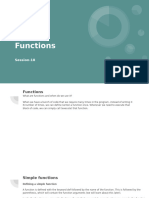FunctionInPython
Uploaded by
rathodevv6FunctionInPython
Uploaded by
rathodevv6MMN BCATY
2.3] Defining and calling functions, passing arguments to functions
What is Function?
In Python, the function is a block of code defined with a name.
We use functions whenever we need to perform the same task multiple
times without writing the same code again.
It can take arguments and returns the value.
Function improves efficiency and reduces errors because of the reusability
of a code.
Once we create a function, we can call it anywhere and anytime.
The benefit of using a function is reusability and modularity.
Python support two types of functions
1. Built-in function
2. User-defined function
Built-in function
The functions which are come along with Python itself are called a built-in
function or predefined function.
Some of them are listed below.
range(), id(), type(), input(), eval() etc.
User-defined function
Functions which are created by programmer explicitly according to the
requirement are called a user-defined function.
Creating a Function
Use the following steps to to define a function in Python.
Use the def keyword with the function name to define a function.
Next, pass the number of parameters as per your requirement. (Optional).
Mr. D. S. Kiwde Page 1
MMN BCATY
Next, define the function body with a block of code. This block of code is
nothing but the action you wanted to perform.
In Python, no need to specify curly braces for the function body. The
only indentation is essential to separate code blocks. Otherwise, you will get an
error.
Syntax of creating a function
def function_name(parameter1, parameter2):
# function body
# write some action
return value
Here,
function_name:
Function name is the name of the function. We can give any
name to function.
parameter:
Parameter is the value passed to the function. We can pass any
number of parameters. Function body uses the parameter’s value to
perform an action
function_body:The function body is a block of code that performs some task.
This block of code is nothing but the action you wanted to accomplish.
return value: Return value is the output of the function.
Note: While defining a function, we use two keywords, def (mandatory) and
return (optional).
Mr. D. S. Kiwde Page 2
MMN BCATY
Creating a function without any parameters
Now, Let’s the example of creating a simple function that prints a welcome
message.
# function
def message():
print("Welcome to Python")
# call function using its name
message()
Output
Welcome to Python
Mr. D. S. Kiwde Page 3
MMN BCATY
Creating a function with parameters
Let’s create a function that takes two parameters and displays their values.
In this example, we are creating function with two parameters ‘ name’ and ‘age’.
# function
def course_func(name, course_name):
print("Hello", name, "Welcome to MMN")
print("Your course name is", course_name)
# call function
course_func('DSK', 'Python')
Output
Hello DSK Welcome to MMN
Your course name is Python
Creating a function with parameters and return value
1. Functions can return a value.
2. The return value is the output of the function.
3. Use the return keyword to return value from a function.
Mr. D. S. Kiwde Page 4
MMN BCATY
Calling a function
Once we defined a function or finalized structure, we can call that function
by using its name.
We can also call that function from another function or program by
importing it.
To call a function, use the name of the function with the parenthesis, and if
the function accepts parameters, then pass those parameters in the parenthesis.
Example
def even_odd(n):
# check number is even or odd
if n % 2 == 0:
print('Even number')
else:
print('Odd Number')
# calling function by its name
even_odd(19)
# Output Odd Number
Mr. D. S. Kiwde Page 5
You might also like
- Back Testing With 99 Percent Modelling V1No ratings yetBack Testing With 99 Percent Modelling V14 pages
- On Translating Arabic (Cultural Approach) - Opt100% (1)On Translating Arabic (Cultural Approach) - Opt238 pages
- Package Unit Instrumentation Specification - TBE and VDR50% (2)Package Unit Instrumentation Specification - TBE and VDR53 pages
- 12 Computer Science Unit 1 Computational Thinking and ProgrammingNo ratings yet12 Computer Science Unit 1 Computational Thinking and Programming37 pages
- ECONTENT OF FUNCTIONS CHAPTER OF PYTHON XIINo ratings yetECONTENT OF FUNCTIONS CHAPTER OF PYTHON XII18 pages
- Python Advanced Programming: The Guide to Learn Python Programming. Reference with Exercises and Samples About Dynamical Programming, Multithreading, Multiprocessing, Debugging, Testing and MoreFrom EverandPython Advanced Programming: The Guide to Learn Python Programming. Reference with Exercises and Samples About Dynamical Programming, Multithreading, Multiprocessing, Debugging, Testing and MoreNo ratings yet
- Introduction to Python Programming: Do your first steps into programming with pythonFrom EverandIntroduction to Python Programming: Do your first steps into programming with pythonNo ratings yet
- Manisha - Smart Phones Vs DSLR - Final - 2020No ratings yetManisha - Smart Phones Vs DSLR - Final - 202034 pages
- K320i Successfully Unlocked in Seconds Cid 50 Here!!No ratings yetK320i Successfully Unlocked in Seconds Cid 50 Here!!5 pages
- Salesforce Integration Interview Questions and AnswersNo ratings yetSalesforce Integration Interview Questions and Answers4 pages
- GPS Tracker and Fuel Sensor Installation Steps 1.2-1No ratings yetGPS Tracker and Fuel Sensor Installation Steps 1.2-12 pages
- 2015 01 19 Reportserver Configguide 2.2No ratings yet2015 01 19 Reportserver Configguide 2.258 pages
- Package Unit Instrumentation Specification - TBE and VDRPackage Unit Instrumentation Specification - TBE and VDR
- 12 Computer Science Unit 1 Computational Thinking and Programming12 Computer Science Unit 1 Computational Thinking and Programming
- Python Advanced Programming: The Guide to Learn Python Programming. Reference with Exercises and Samples About Dynamical Programming, Multithreading, Multiprocessing, Debugging, Testing and MoreFrom EverandPython Advanced Programming: The Guide to Learn Python Programming. Reference with Exercises and Samples About Dynamical Programming, Multithreading, Multiprocessing, Debugging, Testing and More
- Introduction to Python Programming: Do your first steps into programming with pythonFrom EverandIntroduction to Python Programming: Do your first steps into programming with python
- K320i Successfully Unlocked in Seconds Cid 50 Here!!K320i Successfully Unlocked in Seconds Cid 50 Here!!
- Salesforce Integration Interview Questions and AnswersSalesforce Integration Interview Questions and Answers
- GPS Tracker and Fuel Sensor Installation Steps 1.2-1GPS Tracker and Fuel Sensor Installation Steps 1.2-1

























































































